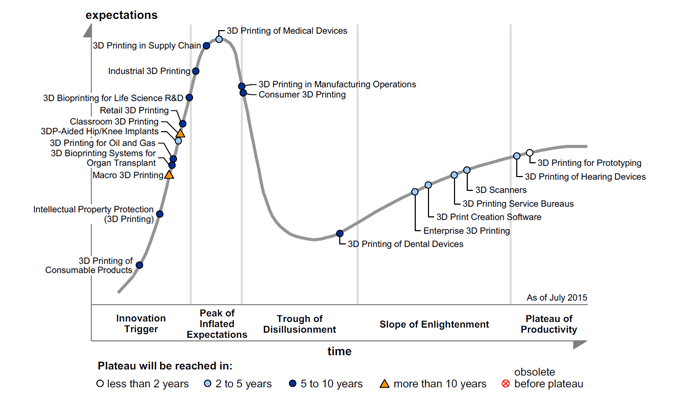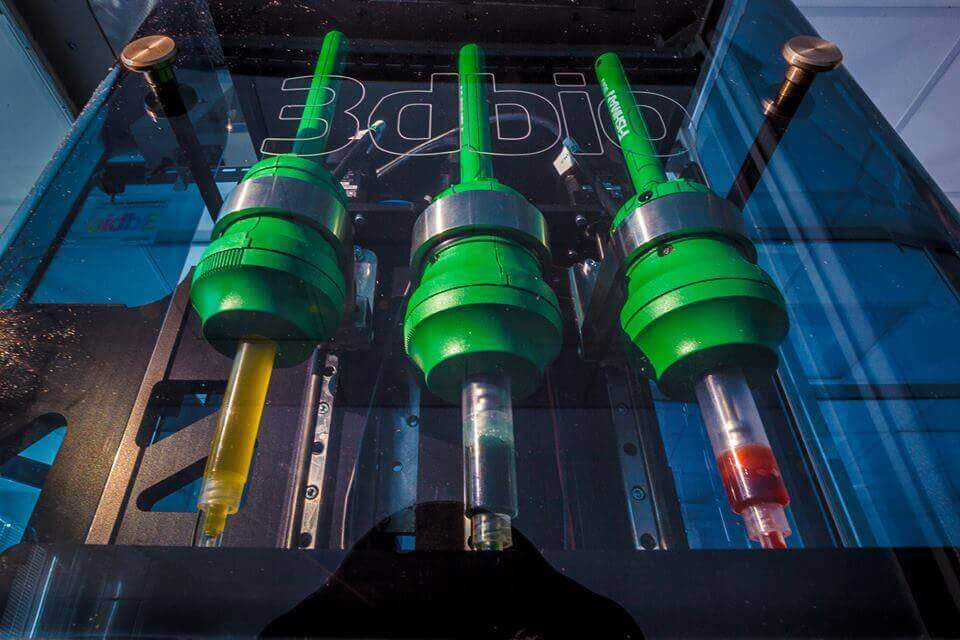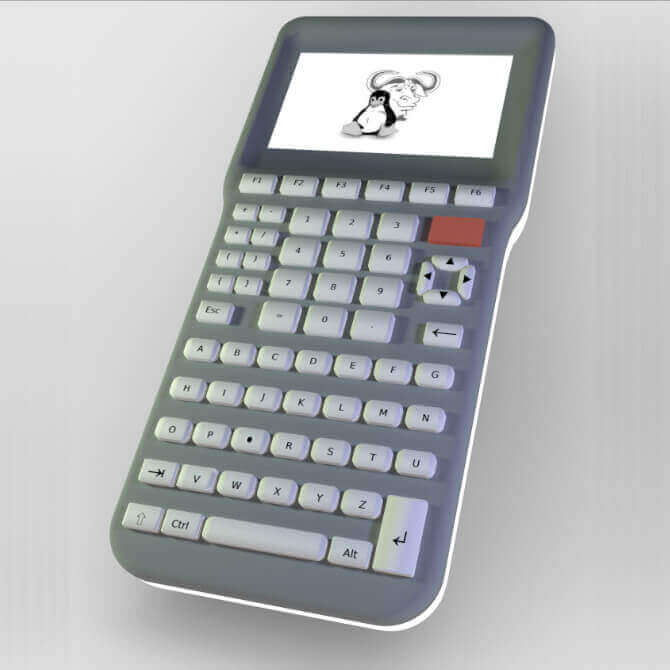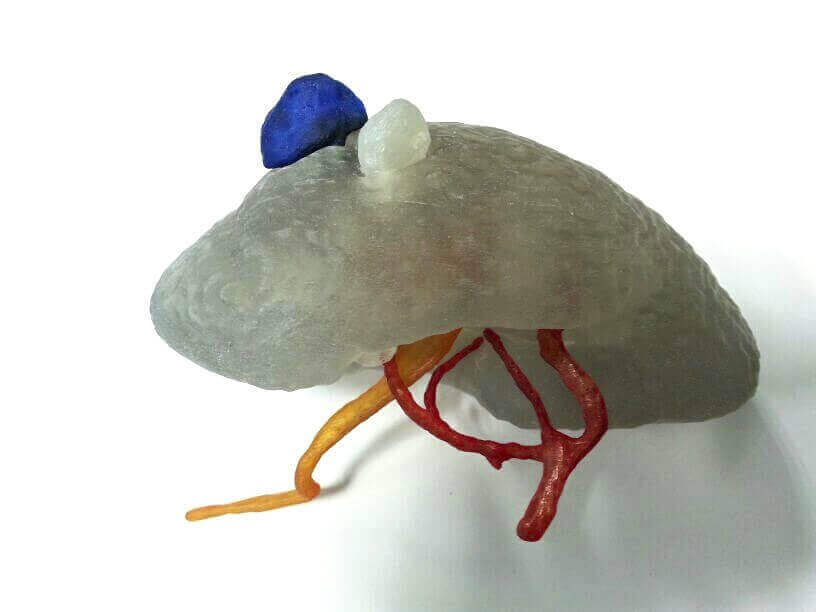Why should you read this: to find out what is coming next in of 3D printing.
3D Printing is getting into every single sector of manufacturing, from automotive to regenerative medicine. That explains why Gartner, one of the most important industry analysis firms in the world, has published a study featuring its very recognizable “Hype Curve”, only catered specifically to 3D printing sectors.
For those unfamiliar with it: The Hype Curve is a graph that Gartner uses to explain how the buzz around a new, potentially disruptive technology translates into a “disillusionment” phase when the public comes to grip with the technology’s grip. This “peak” also has a positive effect on the long terms as it sets a “spark” to a subsequent phase of organic and real (albeit more controlled) growth, as the new technology actually makes its way into everyday life.
Making Sense of New Technologies

“The Hype Cycle for Emerging Technologies is the broadest aggregate Gartner Hype Cycle, featuring technologies that are the focus of attention because of particularly high levels of interest, and those that Gartner believes have the potential for significant impact,” explained Betsy Burton, vice president and distinguished analyst at Gartner. “This year, we encourage CIOs and other IT leaders to dedicate time and energy focused on innovation, rather than just incremental business advancement, while also gaining inspiration by scanning beyond the bounds of their industry.”
In the past, this curve was used to depict all technologies, with 3D printing being among them. In the latest version of this previous graph, released in 2015, Enterprise 3D printing is already farther along the organic growth curve. Consumer 3D printing is on the downward side of the hype phase. Bioprinting is moving up the hype curve. In the new study, Hype Curve graph goes more in depth into the world of 3D printing, analyzing several different applications of this technology. Let’s take a look a what they are.
1. Consumables and Bioprinting On Uprise

The first thing that pops up is that 3D printing of consumable products is the application of 3D printing that is the farthest away, It’s even farther than the 3D bioprinting of organs for transplants. It must be said, however, that bioprinting could be more even hyped up than consumable products 3D printing since its potential effect on people’s lives is even greater. In fact, this is exactly what they Hype Curve describes.
That consumer 3D printing is far away makes sense since the technology needs to become much faster, reliable and materials science needs to advance significantly. One other factor slowing down this aspect of 3D printing is the absence of a true necessity. Some established manufacturers may even resist it, since it would obligate them to radically change their business models.
2. Industry Comes First

Curiously enough the 3D printing applications that appear to be more established are also the more “boring” ones: rapid prototyping, hearing devices, industrial 3D scanning… This is likely because we often tend to see as “boring” the processes that are already part of our everyday lives, even more so it they are used at an industrial level. Thus we are not even really aware they are taking place. Other applications that are reaching this “Productivity Plateau”, as Gartner describes it, are the service bureaus, dental services, and 3D modeling software for physical parts.
Getting back to the “hype”, Consumer 3D printing (that is the adoption by consumers of home 3D printer) is past its peak and rapidly losing media interest. It finds itself in the middle of the “Through of Disillusionment”, heading for the “Slope of Enlightenment” and paving the way to real market adoption. I can personally testify to the veracity of this trend as many larger retailers and distributors worldwide are expressing a growing interest for it.
3. Medical is Booming

Medical and Industrial 3D printing is at or near the peak of the hype curve right now. Everyone is realizing the incredible potential that these technologies hold for a more personalized healthcare and a more efficient supply chain and workflow. The problem is that while many medical professional and manufacturing companies would like to implement 3D printing most do not yet fully understand how and where to do it more efficiently. This will lead to a subsequent phase of disillusion, as new generations of professionals that are more familiar with the technology’s potential make their way. These alternating phases generally take between three to five years.
Bioprinting for research is on the uprise as far as awareness is concerned, and “commercial” bioprinting is trailing not far behind. Just about every scientist in the bioengineering and regenerative medicine sector is becoming aware of the possibilities offered by bioprinting technologies although information is still scattered and unclear. At the same time we are already able to bioprint simpler, basic biological structures for implantation, for example ears and tracheas, and their commercial adoption is only determined by regulatory policies and testing.
4. You Can’t Stop Disruption
The same is true for 3D printed consumer products, whose ascent, in the graph, come right after the boom of IP and copyrighting issues. Gartner predicts that this aspect will become a major hype factor in the future, in a way similar to what happened with the content industry. The rise of digital distribution systems for music, movies and video games followed a period of severe uncertainty and media hype relating to the issue of online copyright protection and piracy. When these factors will pertain to physical objects, the consequences may be even more disruptive.
The Gartner Hype Curve has been proving remarkably accurate and has provided a mean to make sense of the craziness often surrounding new technologies, something particularly true of 3D printing since it became of public domain. Its accuracy shows that new, beneficial technologies rarely can be stopped. That‘s very true for 3D printing.
License: The text of "Gartner’s 3D Printing Hype Curve: The Best is Yet to Come" by All3DP is licensed under a Creative Commons Attribution 4.0 International License.